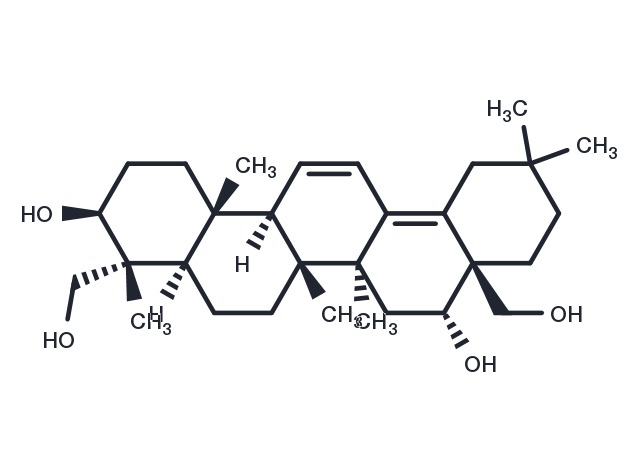Powder: -20°C for 3 years | In solvent: -80°C for 1 year


Saikogenin D possesses a dual effect: an inhibition of A23187-induced PGE2 production without a direct inhibition of cyclooxygenase activity; and an elevation of [Ca2+]i that is attributed to Ca2+ release from intracellular stores. Saikogenin D has immunomodulatory effect, it can attenuate IL-6 production in LPS-stimulated alveolar macrophages of B6 more than in that of BALB.

| Pack Size | Availability | Price/USD | Quantity |
|---|---|---|---|
| 5 mg | 5 days | $ 241.00 | |
| 1 mL * 10 mM (in DMSO) | 5 days | $ 460.00 |
| Description | Saikogenin D possesses a dual effect: an inhibition of A23187-induced PGE2 production without a direct inhibition of cyclooxygenase activity; and an elevation of [Ca2+]i that is attributed to Ca2+ release from intracellular stores. Saikogenin D has immunomodulatory effect, it can attenuate IL-6 production in LPS-stimulated alveolar macrophages of B6 more than in that of BALB. |
| In vitro | Saikogenin D (1-20 microM) inhibited PGE2 production induced by the Ca2+ ionophore A23187 in a concentration-dependent manner with the IC50 of about 3 microM. Saikogenin D did not affect the conversion of arachidonic acid into PGE2 in microsomal preparations. On the other hand, Saikogenin D elevated [Ca2+]i in a concentration-dependent manner (10-100 microM) with the EC50 value of about 35 microM in the presence or absence of extracellular Ca2+. |
| Source |
| Molecular Weight | 472.7 |
| Formula | C30H48O4 |
| CAS No. | 5573-16-0 |
Powder: -20°C for 3 years | In solvent: -80°C for 1 year
You can also refer to dose conversion for different animals. More
bottom
Please see Inhibitor Handling Instructions for more frequently ask questions. Topics include: how to prepare stock solutions, how to store products, and cautions on cell-based assays & animal experiments, etc.
Saikogenin D 5573-16-0 GPCR/G Protein Immunology/Inflammation Membrane transporter/Ion channel Metabolism IL Receptor Calcium Channel Prostaglandin Receptor inhibitor inhibit
